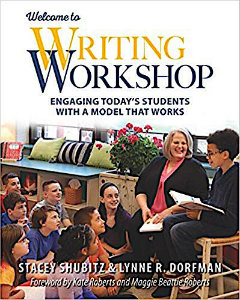Teaching Students When to Abandon a Book
By Lynne R. Dorfman
At the beginning of the year, it is important to teach our readers how to navigate the classroom and school library and how to choose books they want to read and are able to read.
We know our students choose books to read with different purposes in mind. Teaching readers how to make these choices is an important life-long skill.
But what about making the choice to abandon a book?
I remember the personal “reading rule” I lived by for years and years – if I chose a book and started it, then I had to finish it. There were books every year that I struggled with, bored with the content or struggling with the author’s style.
And then the day came . . .
There was this one book – a present from a friend – that was taking me a small eternity to read. I think I was about sixty pages into the book when I realized that my reading time had become drudgery. I had never hated a book before, but I hated this one.
It was really hard, but I took the book to school and placed it in the librarian’s office where Sue had created some shelves for teachers to share books with each other – kind of like the small lending libraries you see in neighborhoods.
In some small way I felt like a failure. I also felt bad about passing the book on to colleagues, but you never know – someone else might like it. Even though I felt guilty about breaking my rule, it felt good abandoning a read that just wasn’t a good fit for me.
And what about my students?
I had never told my students they had to finish reading a book that failed to engage them. At the same time, we had never discussed the possibility of abandonment. I wondered how many of my students believed that once they chose a book for independent reading time, they had to finish it, whether they were engaged with its content or not.
I decided we needed a readerly discussion, starting with my admission about the books I have let go in the past five years or so and how it makes me feel to have that control over my personal reading.
I told them that abandoning a book can be a good thing. Most of my students have several after-school activities, and some of them have part-time jobs. Their time is precious, and none of them can waste a single moment trying to finish a book that is unsatisfying, too difficult, or disappointing.
I told them that I wished a teacher had told me while I was in school that giving up was an okay option because it took me years after completing college to allow myself to abandon a book that had been a poor choice for me.
I also felt it was important for me to teach them when to give a book a second chance, and how to “book shop” carefully and thoughtfully to try to make the best choices so the act of abandoning a book does not happen often. Simply put: when students know how to choose wisely, they will likely read a book from cover to cover.
Choice belongs to the reader
We can offer suggestions, provide guidance, and even physically hand books we love to our readers, but if the book isn’t a good match for the reader, it won’t be read or enjoyed.
Choice means the reader also has the right to abandon a book. Providing guidelines for abandoning a book helps readers own their choices. In a conference, you can talk about abandoning the book and hear from the reader about their decision. I suggest creating an anchor chart on when to abandon a book with suggestions from the entire class along with suggestions from you.

During your kidwatching time, observe students who are finishing books too early, who are browsing but never making a final selection, or who never seem to read a book all the way through. Make some notes and have a quick conference to find out why. Even though these students may be middle schoolers, they still may need a demonstration or minilesson to explore strategies for choosing independent reads wisely.
Sample anchor chart:
When should I abandon a book?
- I don’t know enough about the topic or setting to understand the ideas.
- I’ve lost interest (I may return to it in the future).
- I’ve changed my mind because it is too hard – I don’t know a lot of the words.
- The book is too easy – I need more of a challenge.
- The book is too long – I’ve been reading it all week, and I am nowhere near the end!
- I don’t believe the author is an expert on this subject.
- I don’t think the main character(s) is believable (or I simply don’t like them).
- I cannot connect with or identify with any of the characters in the story.
- I need a more recently published book to learn about ______ (for example, space travel).
- It doesn’t feel like the story is going anywhere (very slow-moving plot).
- I thought it was going to be about one thing, but it turned out to be about something else.
- I want to join a book club, so I need to abandon this book for now.
- I am super-excited to read something else! (A new book, for instance, in the school or classroom library or a book that is being passed around and it’s your turn to read it.)
So how do my students decide whether to keep reading or move on?
- Read more than just the first few pages. In the classroom, I tell my chapter book readers that they should read about 50 pages before making a final decision to abandon. Sometimes books that start out slow turn out to be great reads!
- Get to know other readers in your family and in your class who enjoy the same kind of books you do so you can get recommendations that will most likely help you find a book you’ll really enjoy!
- Talk about the book with someone who has read it. Readers may need help clearing up early confusions about complex characters, unfamiliar settings, or plot twists. Once your students understand these elements, they may be more willing to continue reading it independently.
- Stop and have a conversation about the book as you read! Readers are not alone. (Whenever possible, it’s great to have several copies of a book on your classroom library shelf. That way students can sometimes place a “Wanted” sticky note or poster on the bulletin board to request a partner(s) to read the same book they are choosing in order to have an ongoing conversation.)
- Build reading stamina. Children must have structured reading time. Some readers choose lengthy books (think the Redwall series by Brian Jacques, often 400 pages plus) only to abandon them because they lose focus or don’t know how to pace themselves. Reading takes practice, and students who need more reading practice might start with a series of short, related high-interest books (like The Virginia Mysteries books by Steven K. Smith).
Encourage children to read a little more each day! Provide choice and variety and you will increase the readership in your community. Teach students when to abandon a book. It will give them a sense of ownership over their reading process and help them build a reading identity.
In a world where there is so much demanding our attention, it’s important to make the best use of our reading time!





































I didn’t learn about this as a child because my mum chose or helped me choose very good books that I loved. I even enjoyed some of her childhood books and adopted them into my bookcase{s}.